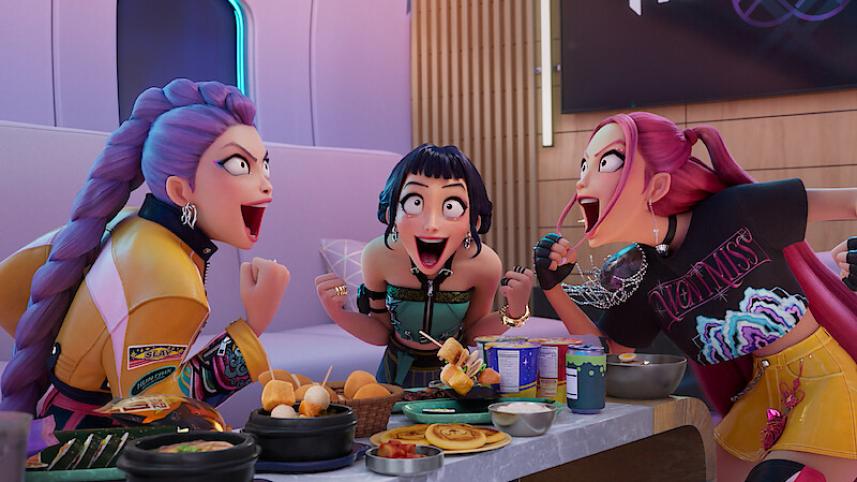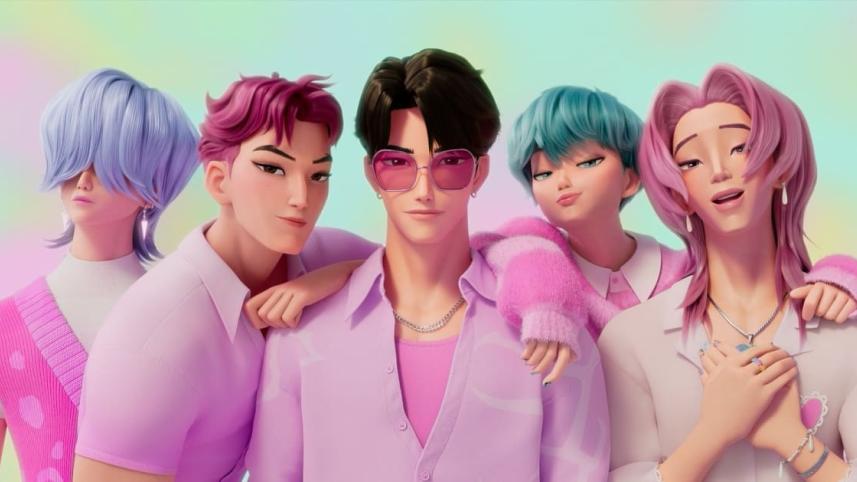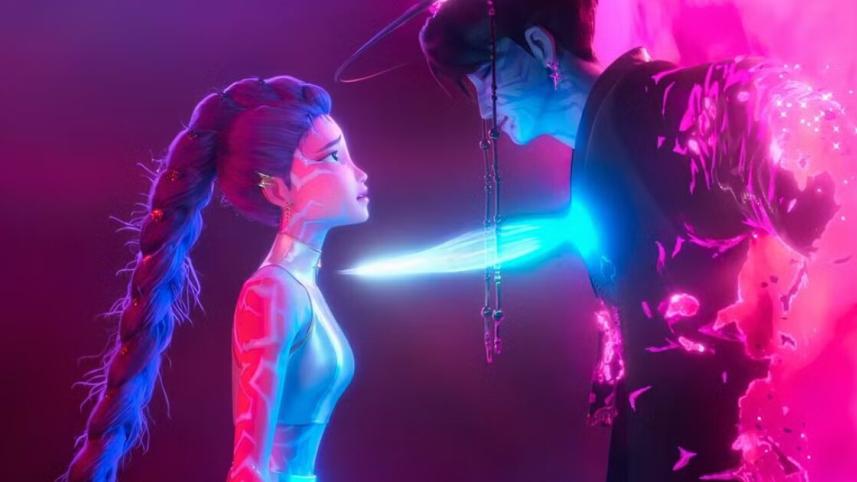A musical, a satire, a lament: The many dimensions of ‘KPop Demon Hunters’

I found myself wondering why an animated film had suddenly taken the world by storm, topping Netflix's global charts. Animated titles rarely reach this kind of universal acclaim unless they are tied to a massive franchise, and yet here was "KPop Demon Hunters", a seemingly niche story about idols battling demons, sitting at number one. Curiosity got the better of me, and I decided to dive in. What I found was a film that managed to wrap a playful premise around a surprisingly layered commentary on fame, identity, and the relentless machine of modern pop culture.
The premise is deceptively simple: three girls from the latest generation of demon hunters are tasked with maintaining the Honmoon, a mystical barrier that protects humanity from Gwi-ma's demons. This generational relay of guardianship is the backbone of the film, yet the narrative does not simply linger on battles between good and evil. It interlaces them with the anxieties, ambitions, and fractured identities of the young women at its heart, grounding the fantastical in a world of harsh expectations and fragile dreams. The trio of protagonists, Zoey, Mira, and Rumi, are rendered with the kind of care that elevates archetypes into characters who feel lived-in. Zoey wrestles with the tension of being both American and Korean, Mira navigates the isolating consequences of wealth and mistrust, and Rumi, the central force among them, embodies the struggle of self-acceptance under the scrutiny of an industry that commodifies perfection.

For me, what immediately stands out in "KPop Demon Hunters" is its unabashed embrace of the K-pop world not merely as an aesthetic, but as a system with its own hierarchies, exploitations, and contradictions. The Saja Boys, a manufactured boy group designed to serve the antagonist Gwi-Ma's hunger for souls, are not just villains or comic relief. They are a mirror held up to the idol machinery, a reminder of how parasocial desire, sexualisation, and glorification shape real performers. Each of their exaggerated personas, from Baby's deliberately infantilised shtick to Romance's performative flirtations, reflects a specific trope fans will recognise. Jinu, the most developed among them, is given depth that suggests what the others might have become had the film not been so constrained by its ninety-minute runtime. This is one of the recurring criticisms that echoed across many viewers; the world is rich, the characters compelling, but the story often feels like it is sprinting when it should be strolling.
The brevity would not be an issue if the film had simpler ambitions, but this is a movie that wants to discuss identity, generational trauma, fan culture, corporate greed, the erosion of artistry in pursuit of global validation, and the quiet bonds between young women trying to trust one another in a cutthroat environment. There are moments when it succeeds brilliantly, a fleeting look between two characters that says more than dialogue ever could, a line about the pressure of being the perfect child that lands like a whisper of confession, and moments when it feels like entire arcs are left unexplored, sketches where there should have been portraits. The relationship between the girls evolves believably; their camaraderie is earned through shared vulnerabilities, yet the antagonists and side characters often feel like they were waiting for a series rather than a standalone film to give them dimension.

Where the film triumphs, however, is in its music and visual rhythm. The soundtrack is startlingly good, not just as accompaniment but as narrative scaffolding. The songs, many have noted, outshine contemporary K-pop tracks in their craft, seamlessly integrated into the story rather than added as afterthoughts. Each performance scene serves a dual purpose: to entertain and to reveal something about the performers, their masks, and their fractures. The animation, too, is a feast with character designs that flirt with exaggeration without tipping into caricature, colour palettes that swing between neon euphoria and haunted shadow, and choreography that feels weightless yet intentional. It is a film that knows how to move, and in its movement, how to feel alive. Bobby, the manager of the central trio, is another small but significant subversion. Instead of the often-documented tyrannical managers who exploit or emotionally damage their groups, Bobby is portrayed as a source of support, humour, and grounding. This choice alone signals that the creators are not interested in cheap vilification but in reframing archetypes, acknowledging the industry's failings without reducing every player to a monster. It is this refusal to flatten complexity that allows the film to resonate beyond its surface appeal.
Yet, for all its playfulness, "KPop Demon Hunters" is not afraid to graze the darker edges of idol culture. It shows how idols are commodified, how their humanity is often erased in the glare of fan projection, how globalisation has not always meant liberation for the art form, but sometimes its dilution. There are passing but potent nods to the pressure to sing in English to capture Western markets, the loss of cultural specificity in pursuit of broader streams, the transactional nature of sponsorships, and the toll of living as both a product and a person. The film does not dwell long enough on these to become a critique in the traditional sense, but they ripple through the narrative like undertones that make the sweetness sharper.

I believe one of the most poignant aspects of the film is its commentary on perfection. The girls are not simply fighting demons; they are fighting the gnawing voice that tells them to be better, prettier, more compliant, more marketable. Anxiety, impostor syndrome, and the hunger to belong are treated with a lightness of touch that makes them accessible to younger viewers without trivialising them for older ones. The decision to keep the runtime tight was likely made to maintain this balance; an overlong meditation on the toxicity of fame might have tipped the tone from playful to didactic, but it does leave the sense that something fuller, messier, more daring is just out of reach. The comedic streak running through the film prevents it from becoming too heavy, often surfacing in the interactions between the girls and their outlandish adversaries. Moments like Baby mocking his own infantilisation or the Saja Boys leaning into their absurdity show a self-awareness that keeps the satire buoyant. Even in its critique, the film is affectionate. It does not despise K-pop; it mourns what it has lost and celebrates what it could still become.
In the end, this is not a flawless film, but it is a fiercely likeable one. Its imperfections are the kind that speak to ambition rather than laziness. It tries to do too much, yes, but in trying, it manages moments of surprising intimacy and cultural resonance. It is a movie about girls who fight demons, but also about girls who fight the impossible demands of a world that wants to consume them whole. It is a musical, a satire, a love letter, and at times, a lament. And when the final song fades and the credits roll, you are left with the sense that something tender and defiant has been offered to you. Waiting another nine years for a follow-up would be cruel. This world is ready to be lived in now. Whether it returns as another film or as an episodic exploration, what matters is that it does not vanish into the algorithmic churn of streaming content. "KPop Demon Hunters" deserves its second act, and perhaps, if it gets it, the ghosts it dances with this time will be given the space to fully haunt us.




 For all latest news, follow The Daily Star's Google News channel.
For all latest news, follow The Daily Star's Google News channel. 
Comments